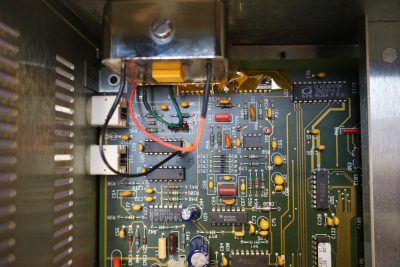I got a Wavetek 395 arbitrary waveform generator (AWG) last year. Unlike my other equipment (such as HP 8566B, HP 5350B, HP 8642B and Racal Dana 1992) which all came with high stability ovenized crystal oscillators, the Wavetek 395 only comes with a 100ppm crystal. While the stock timebase is perfectly fine for all but the most serious measurements, I decided to upgrade it to an oven controlled crystal oscillator (OCXO) as I happen to have a Vectron CO-717B58N lying around.
The onboard 10MHz reference in the Wavetek 395 is a FOX F1144H series crystal oscillator which operates under 5V and has TTL compatible output, and the Vectron OCXO I have is also a TTL compatible one. So in theory, the upgrade should be pretty straight forward as it only requires desoldering the original crystal and wiring the OCXO in its pace.
The main difference between the OCXO and the metal can crystal oscillator is that OCXO draws much more current (more than 700mA at its peak), so this could put strain on the 5V rail if the power supply is not designed to handle such a heavy load. Luckily, the switching power supply for the Wavetek 395 operates with ample margin. Its 5V output is rated for 10A and the entire unit draws only around 50W in operation so it clearly has enough capacity for the extra current requirement.
As it turned out however, this wasn’t as simple as just a drop-in replacement. After I soldered in the OCXO, the timebase would not output any signal. Upon measuring the supply voltage to the OCXO I realized that the voltage was only at 2.9V, way below the required 5V and thus the oscillator was not in operation. Since the 5V rail remains stable at 5V (I measured the power supply to the other TTL chips on the board), clearly something else is going on.
Upon tracing the power and ground to the oscillator, I realized that the power pin was connected directly to the +5 rail but the ground is switched via the output of a 74ALS04 inverter (to be precise, two gates are paralleled together to drive the oscillator). And this explains why as the current sinking capability of the gates in a standard TTL IC is only tens of milliamps at the most and is not sufficient to drive an OCXO.
Since there is no schematics available for the Wavetek 395, I wasn’t entirely sure why the oscillator needs to be switched on and off. But by rerouting the ground connection to the real ground instead of the inverter output solved the problem. You can see this in the picture below. The black wire is the ground from the OCXO and it’s soldered onto the common ground. With this modification, the OCXO works perfectly.
I mounted the OCXO on the side panel via double-sided tape. The tape also serves as an insulator since the circuit ground is isolated from the earth ground. This mounting position also allows me to adjust the OCXO in the future via the adjustment port on the top if calibration is needed.
For those who wanted to watch me doing the upgrade, here is a short video:
Update
The reason the operation of the crystal was controlled by the 74ALS04 is that Wavetek 395 allows using external 10MHz clock reference. And when an external reference is connected to the rear panel, the internal 10MHz clock is disabled. By hooking the OCXO’s ground directly to the circuit ground, the OCXO will no longer be disabled when external reference signal is present which in essence disables the external reference feature. I will probably add buffer to the 74ALS04 output so that the OCXO can be turned off when an external reference is used.


